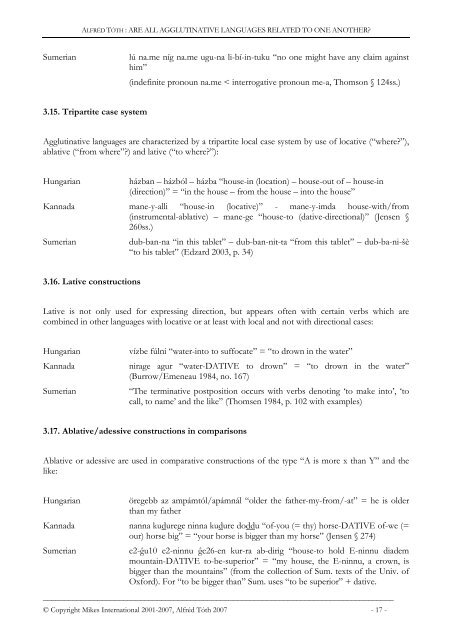Are all agglutinative languages related to one another?
Are all agglutinative languages related to one another?
Are all agglutinative languages related to one another?
Create successful ePaper yourself
Turn your PDF publications into a flip-book with our unique Google optimized e-Paper software.
ALFRÉD TÓTH : ARE ALL AGGLUTINATIVE LANGUAGES RELATED TO ONE ANOTHER?<br />
Sumerian lú na.me níg na.me ugu-na li-bí-in-tuku “no <strong>one</strong> might have any claim against<br />
him”<br />
3.15. Tripartite case system<br />
(indefinite pronoun na.me < interrogative pronoun me-a, Thomson § 124ss.)<br />
Agglutinative <strong>languages</strong> are characterized by a tripartite local case system by use of locative (“where?”),<br />
ablative (“from where”?) and lative (“<strong>to</strong> where?”):<br />
Hungarian házban – házból – házba “house-in (location) – house-out of – house-in<br />
(direction)” = “in the house – from the house – in<strong>to</strong> the house”<br />
Kannada mane-y-<strong>all</strong>i “house-in (locative)” - mane-y-imda house-with/from<br />
(instrumental-ablative) – mane-ge “house-<strong>to</strong> (dative-directional)” (Jensen §<br />
260ss.)<br />
Sumerian dub-ban-na “in this tablet” – dub-ban-nit-ta “from this tablet” – dub-ba-ni-šè<br />
“<strong>to</strong> his tablet” (Edzard 2003, p. 34)<br />
3.16. Lative constructions<br />
Lative is not only used for expressing direction, but appears often with certain verbs which are<br />
combined in other <strong>languages</strong> with locative or at least with local and not with directional cases:<br />
Hungarian vízbe fúlni “water-in<strong>to</strong> <strong>to</strong> suffocate” = “<strong>to</strong> drown in the water”<br />
Kannada nirage agur “water-DATIVE <strong>to</strong> drown” = “<strong>to</strong> drown in the water”<br />
(Burrow/Emeneau 1984, no. 167)<br />
Sumerian “The terminative postposition occurs with verbs denoting ‘<strong>to</strong> make in<strong>to</strong>’, ‘<strong>to</strong><br />
c<strong>all</strong>, <strong>to</strong> name’ and the like” (Thomsen 1984, p. 102 with examples)<br />
3.17. Ablative/adessive constructions in comparisons<br />
Ablative or adessive are used in comparative constructions of the type “A is more x than Y” and the<br />
like:<br />
Hungarian öregebb az ampámtól/apámnál “older the father-my-from/-at” = he is older<br />
than my father<br />
Kannada nanna kudurege ninna kudure doddu “of-you (= thy) horse-DATIVE of-we (=<br />
our) horse big” = “your horse is bigger than my horse” (Jensen § 274)<br />
Sumerian e2-ĝu10 e2-ninnu ĝe26-en kur-ra ab-dirig “house-<strong>to</strong> hold E-ninnu diadem<br />
mountain-DATIVE <strong>to</strong>-be-superior” = “my house, the E-ninnu, a crown, is<br />
bigger than the mountains” (from the collection of Sum. texts of the Univ. of<br />
Oxford). For “<strong>to</strong> be bigger than” Sum. uses “<strong>to</strong> be superior” + dative.<br />
___________________________________________________________________________________<br />
© Copyright Mikes International 2001-2007, Alfréd Tóth 2007 - 17 -

















